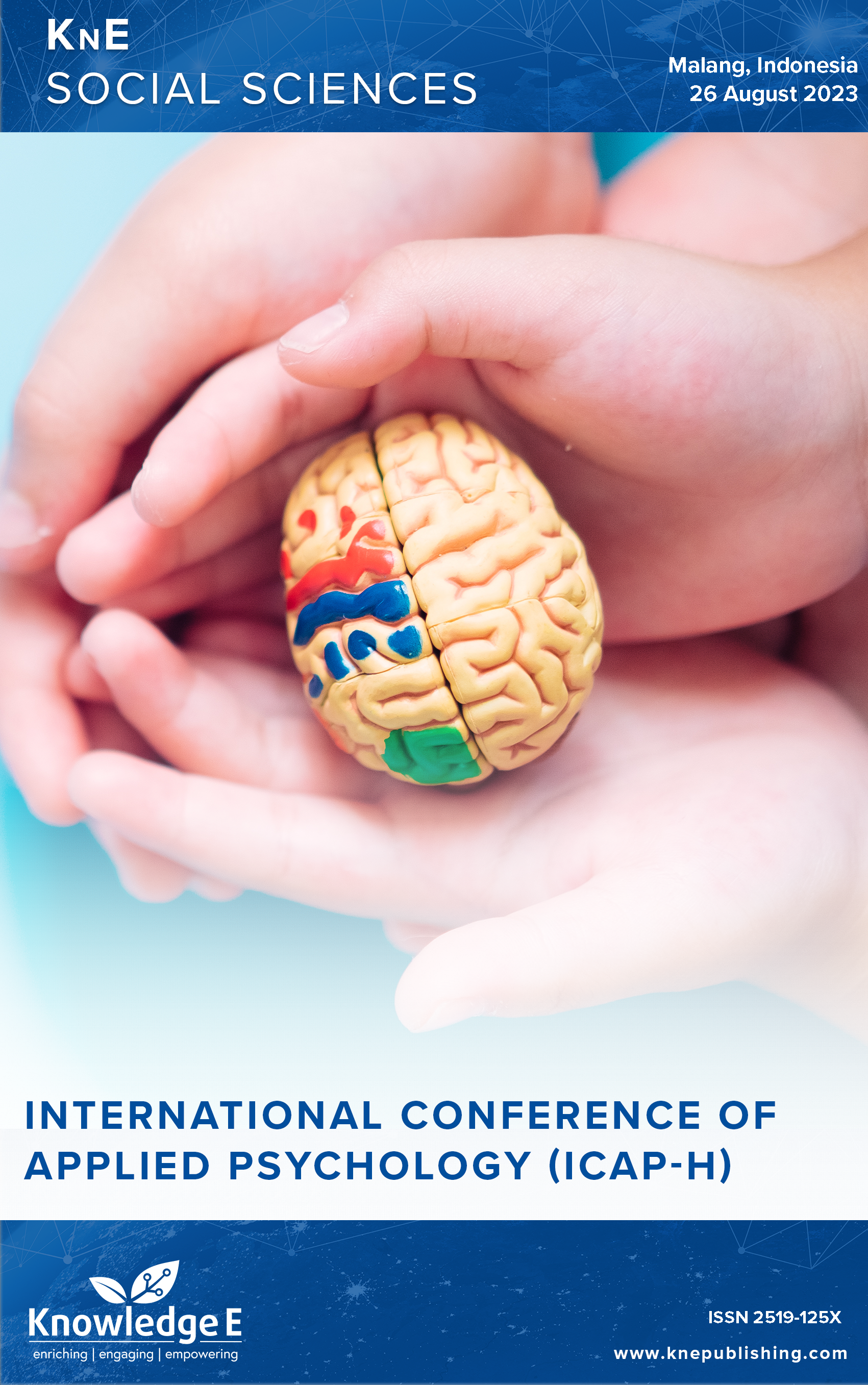The Effect of Family Communication on Depressive Symptoms in Adolescents Who Have Step-parents
DOI:
https://doi.org/10.18502/kss.v9i5.15164Abstract
The relationship between adolescents and their stepparents is a unique one because the relationship is established without blood ties. Family functioning is the ability of each member to interact and take roles in the family so that closeness is established with each family member. This research looks into how family functioning affects the depression symptoms of adolescents who have stepparents. The research used a quantitative approach with an incidental sampling technique. Research subjects were 100 15–19 years old adolescents with stepparents (Mean = 16.89, SD = 1,188). The research instruments used were McMaster Family Functioning Scale (short version) and Beck Depression Inventory. The statistical programs used were Statistical Package for Social Science (SPSS) version 25 and Past3. The result of a simple linear regression analysis tested showed a significantly negative effectof family functioning on the depression symptoms of adolescents who have stepparents (R = –0.92, R2 = 0.85, Pvalue = 0.00). That is, the presence of one of the new parents can predict if the teenager will develop depression in their life. The implications of this reseach are expected to provide understanding to parents of the importance of family communication and it is hoped that parents can provide understanding and reasons for remarriage to children so that children can be more accepting of their stepparents. On the other hand, adolescents who have stepparents are expected to always learn to open up, obey stepparents, and accept their existence as caregivers and educators in the family. The existence of a reciprocal relationship between parents and stepchildren is expected to establish good family relations between the two.
Keywords: depression, family functioning, stepparent, teenagers
References
Feist J, Feist GJ, Roberts T-A. Teori kepribadian. 8th ed., Salemba Humanika; 2017.
Hurlock EB. Psikologi Perkembangan. Jakarta: Erlangga; 2003.
Santrock JW. Remaja. Jakara: Erlangga; 2007.
Notosoedirdjo M, Latipun. Kesehatan mental: Konsep dan penerapan. 4th ed. UMM Press; 2016.
Crook T, Raskin A EJ. Parent-child relationships and adult depression. Child Development. 1981;52:950–957. https://doi.org/10.1111/j.1467-8624.1981.tb03136.x DOI: https://doi.org/10.1111/j.1467-8624.1981.tb03136.x
Santrock JW. Life span development: Perkembangan masa hidup. 13th ed., Jakarta: Erlangga; 2012.
Pawulan RA, Loekmono L, Irawan S. Hubungan antara kelekatan orangtua dengan regulasi emosi remaja pondok pesantren agro “Nuur El-Falah” Salatiga. Psikol Konseling. 2018;13:231–248. https://doi.org/10.24114/konseling.v13i2.12194 DOI: https://doi.org/10.24114/konseling.v13i2.12194
Masarik AS, Conger RD. Stress and child development: A review of the family stress model. Current Opinion in Psychology. 2017;13:85–90. https://doi.org/10.1016/j.copsyc.2016.05.008. DOI: https://doi.org/10.1016/j.copsyc.2016.05.008
Fatimah R, Sunarti E, Hastuti D. Tekanan ekonomi, interaksi orangtua-remaja, dan perkembangan sosial emosi remaja. J Ilmu Kel Dan Konsum. 2020;13:137–150. https://doi.org/https://doi.org/10.24156/jikk.2020.13.2.137 DOI: https://doi.org/10.24156/jikk.2020.13.2.137
Dianovinina K. Depresi pada remaja: Gejala dan permasalahannya. J Psikogenes. 2018;6:69–78. https://doi.org/10.24854/jps.v6i1.634 DOI: https://doi.org/10.24854/jps.v6i1.634
Nevid JS, Rathus SA, Greene B. Psikologi abnormal. 9th ed., Erlangga; 2018.
Visser A V. Constructing new relationships: A thematic analysis of stepmother and stepchild co-construction of close and enduring bonds [Masters thesis]. The University of Guelph; 2015.
Shafer K, Jensen TM, Holmes EK. Divorce stress, stepfamily stress, and depression among emerging adult stepchildren. Journal of Child and Family Studies. 2016;26:851–862. https://doi.org/10.1007/s10826-016-0617-0 DOI: https://doi.org/10.1007/s10826-016-0617-0
Jensen TM, Harris KM. Stepfamily relationship quality and stepchildren’s depression in adolescence and adulthood. Emerging Adulthood 2017;5:191–203. https://doi.org/10.1177/2167696816669901 DOI: https://doi.org/10.1177/2167696816669901
Azwar S. Metode penelitian. Pustaka Belajar: Yogyakarta; 2007.
Periantalo J. Penelitian kuantitatif untuk psikologi. Yogyakarta: Pustaka Belajar; 2016.
Suharsaputra U. Metode kuantitatif, kualitatif, dan tindakan. Bandung: PT. Refika Aditama; 2012.
Rahmawati L, Arneliwati, Elita V. Hubungan dukungan keluarga dengan harga diri remaja di lembaga pemasyarakatan. Jom Psik. 2014;1:1–10. https://doi.org/http://dx.doi.org/10.20473/jn.v15i2.21495. DOI: https://doi.org/10.20473/jn.v15i2.21495
Apriliana A, Zelfia, Rahmawati S. Pengaruh komunikasi keluarga broken home pada tingkat depresi anak remaja di kota makassar. J Ilmu Komun. 2020;1:32–38. DOI: https://doi.org/10.33096/respon.v1i1.19
Nurchahyati EV, Legowo M. Peran keluarga dalam meminimalisir tingkat kekerasan seksual pada anak. J Hawa Stud Pengarus Utamaan Gend Dan Anak. 2022;4:22–30. https://doi.org/10.29300/hawapsga.v4i1 DOI: https://doi.org/10.29300/hawapsga.v4i1.4735
Freed RD, Rubenstein LM, Daryanani I, Olino TM, Alloy LB. The relationship between family functioning and adolescent depressive symptoms: The role of emotional clarity. Journal of Youth and Adolescence. 2016;45:505–519. https://doi.org/10.1007/s10964-016-0429-y DOI: https://doi.org/10.1007/s10964-016-0429-y
Howe TR. Marriages and families in the 21st century: A bioecological approach. West Sussex: Wiley Blackwell; 2015. https://doi.org/10.1002/9781444344714 DOI: https://doi.org/10.1002/9781444344714
Davidson GC, Neale JM. Abnormal psychology. New York: New York: John Wiley & Sons, Inc.; 2002.
Purwadi. Kecenderungan pemecahan masalah pada remaja. Proc Temuan Ilm Nas “Optimalisasi Perkemb Potensi Bangsa” 2007:35–45.
McMakin DL, Burkhouse KL, Olino TM, Siegle GJ, Dahl RE, Silk JS. Affective functioning among early adolescents at high and low familial risk for depression and their mothers: A focus on individual and transactional processes across contexts. Journal of Abnormal Child Psychology. 2011;39:11–22. https://doi.org/10.1007/s10802- 011-9540-4 DOI: https://doi.org/10.1007/s10802-011-9540-4

